Updated October 25, 2018. Originally published November, 2016.
Janine Hasey, UCCE Farm Advisor Sutter/ Yuba/Colusa Counties; Bruce Lampinen, Extension Specialist, UC Davis; and Katherine Jarvis-Shean, UCCE Orchard Advisor Sacramento/ Solano/ Yolo Counties
Training young walnut trees occurs in the first 1-6 years in the life of an orchard. Traditionally it has been done using a modified central leader with a minimum pruning style; the basics behind this pruning style are similar for standard spaced or hedgerow orchards. We believed for decades that if lateral bearing walnuts (most of our varieties) were not pruned, their growth would stall out from early cropping. Research conducted since 2004 investigating pruning versus non-pruning (no heading, low branch removal) on young walnut tree growth and productivity has challenged that paradigm. Results from trials on Howard, Chandler, Tulare, Forde, Solano and Livermore have shown that young walnuts do not need to be pruned in order to keep them growing or to produce adequate yields. In general, unpruned/unheaded trees have produced higher early yields and equivalent yields in year 4 and afterwards compared to minimally pruned trees. We also compared unpruned/unheaded and minimally pruned trees to heavily pruned trees. Heavily pruned walnut trees resulted in smaller trees with lower early yields, and is not recommended.
With more knowledge comes more complexity. Growers now have the option when trees are one year old (first dormant pruning) or two years old (second dormant pruning) to stick with the modified central leader and train using minimum pruning, or to not prune (i.e. not head), which saves on labor and brush disposal costs. Growers interested in trying the unpruned method may want to start small and compare to the minimal pruning method to make sure it fits their management system. Keep in mind, if you start with minimum pruning, changing from pruning to no pruning in the third year may lead to limb breakage.
Below are the main steps comparing training walnuts for years 1-4 using the unpruned/unheaded method and variations of this method to modified central leader with the minimum pruning method. The assumption is a standard-spaced orchard, with differences noted for hedgerow systems. Young walnut trees are sensitive to freezing temperatures which can kill or damage wood so it is best to delay pruning until March or late February at the earliest.
Unpruned/unheaded training method:
One‐year old walnut trees
- Leave the leader (one shoot selected to be the trunk) unheaded. Ten to 12 feet of growth is desirable, trees above 12 feet height can be problematic whether headed or unheaded.
- Any lateral shoots on the leader should be removed.
- Primary buds above 4 to 5 feet from the ground that are necked and have a viable secondary bud below it should be rubbed off to the side so as not to damage the secondary bud. (see minimum pruning section).
- Place a long stake extension on existing stake to support the unpruned leader if needed.
Two and three‐year old walnut trees:
- Remove lower limbs below 4 to 5 feet (3 to 4 feet for hedgerows)
- No other pruning or heading unless lower branches need to be removed for reasons of safety or ease of maintenance and harvest.
- Note that unpruned/unheaded walnuts tend to put on limb extension growth in alternate years. Individual shoots follow a pattern of extension growth (primary scaffold development during second growing season), followed by lateral branching (side branching with 5-8 inches growth) occurring on primary scaffold during the third growing season (Photo 1), followed by another year of extension growth during the fourth growing season (Photo 2). On better soils, extension growth on scaffolds often occurs by mid-summer during the third growing season on unpruned/unheaded trees.
- Unpruned trees tend to grow as a central leader with the primary branches naturally well-spaced along the trunk and at wide angles.
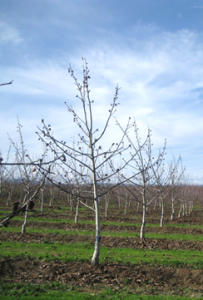
Photo 1. An unpruned tree at the end of the third growing season. Note short shoot growth on primary branches. Photos by B. Lampinen.
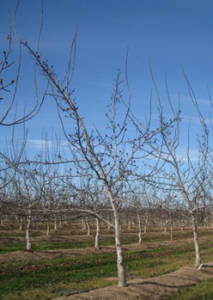
Photo 2. An unpruned/unheaded tree at the end of the fourth growing season. Note the extention growth on the unpruned tree.
Variations of unpruned training method:
An option that has been successful in research trials and in grower’s orchards is a variation of the unpruned method. The trunk is headed at the first dormant pruning as in minimum pruning (see below), but in subsequent years, scaffold limbs (primary, secondary, etc.) are left unheaded. Some thinning of forked limbs or double leaders may be done at the second dormant pruning. This method has been used primarily in Chandler and may not be suitable for very vigorous varieties like Solano.
Modified central leader with minimum pruning method:
Pruning one‐year old walnut trees
- The leader (shoot selected to be the trunk) should reach a minimum height of at least 7 to 8 feet. Ten to 12 feet of growth is desirable, trees above 12 feet height can be problematic whether headed or unheaded. (7-8 feet is sufficient for hedgerow orchards).
- Heading the leader at 8 feet will provide more trunk area to space out scaffolds. The leader should not be headed any less than 6 ½ feet since the first primary scaffold should be at least 5 feet (branches in tree row can be left lower) above the ground to prevent interference with equipment operation (hedgerow – head at 6 feet, first primary should be about 4 feet above ground). Make the heading cut into mature round wood.
- Any lateral shoots on the leader should be removed. One or two non-vigorous shoots arising low on the leader can be stubbed to 2 to 3 buds to aid caliper growth and provide shade on the south and west sides. They will be removed in the next dormant season.
- Primary buds above 5 feet from the ground that are necked and have a viable secondary bud below it should be rubbed off to the side so as not to damage the secondary bud. If left, necked buds form weak limb attachments that are subject to breakage. The secondary bud which is forced to grow will form a wide angle and develop a strong crotch.
- If the shoot selected to be the trunk has not reached sufficient height, cut it to 3 to 6 buds on current season growth and remove competing shoots. A stronger shoot can then be trained as the trunk during the second growing season.
Pruning two‐year old standard-spaced walnut trees:
- The general goal is to select 4 to 6 primary scaffolds arising from the trunk in years two and three. Select the central leader which is typically the topmost branch.
- See above section for height of the first primary scaffold above ground. Select other primary scaffolds to form a spiral pattern around the trunk. Try to space them at least 8 inches apart. Primary scaffolds should never originate directly opposite each other; when this occurs, the leader will have a tendency to get ‘choked out’.
- Selected scaffolds should be angled about 45 degrees from the vertical. Limbs with narrower angles or bark inclusions are usually poorly attached and cannot support heavy crops. Branches with wider angles of attachment may fail to grow vigorously.
- For most lateral bearing varieties, head all primary scaffolds ¼ to ⅓ of current growth depending on vigor and variety. Tulare, Forde, and Solano are very vigorous and need only tipping or no heading of the scaffolds. The leader should be left the longest.
- Remove forked branches on chosen scaffolds to a single branch. Leave remaining unselected branches and small caliper wood unheaded to create early fruiting wood.
Pruning two‐year old hedgerow walnut trees:
- Select a central leader and 2 to 4 side limbs that are oriented in opposite directions in the tree row.
- Remove branches below 3 to 4 feet that will interfere with shaking and flat limbs that grow out into the middles.
- Depending on variety and vigor, selected framework limbs should be headed or tipped (see above) and cut to an outside bud facing into the tree row. Other branches can be left unheaded to fruit early.
Pruning three‐year old standard-spaced or hedgerow walnut trees (Photo 3):
- Choose the strongest, tallest scaffold for the leader and head ¼ to ⅓ of the current growth. Strong secondary scaffolds in a vertical position can be tipped or left unheaded. Head or tip one strong secondary scaffold on the sides of the canopy in each cardinal direction ¼ to ⅓ of the current growth.
- Forked branches can be left but twisted, rubbing or overlapping branches should be removed.
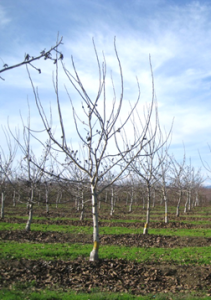
Photo 3. A minimum pruned tree at the end of the third growing season. Note the secondary scaffold extension growth from heading cuts. Photo: B. Lampinen.
Pruning four‐year old standard-spaced walnut trees (Photo 4):
- The leader can be left alone. Strong tertiary scaffolds in a vertical position can be tipped or left unheaded. Head or tip one or two tertiary scaffolds on the sides of the canopy in each cardinal direction ¼ to ⅓ of the current growth. Pruning or heading is usually unnecessary after the fifth growing season if trees have filled their allotted space.
Whether trees are pruned or left unpruned/unheaded, remove suckers from the rootstock.
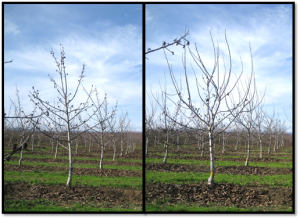
Side by side comparison of a unpruned/unheaded (left) and minimum pruned tree (right) at the end of the third growing season.
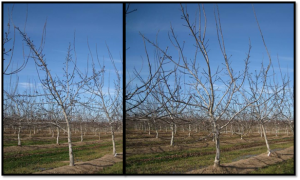
Side by side comparison of unpruned/unheaded tree (left) and minimum pruned tree (right) after 4th growing season.


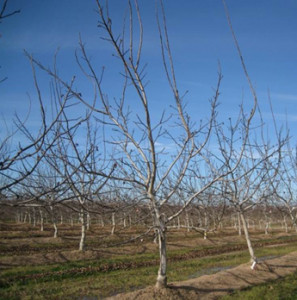
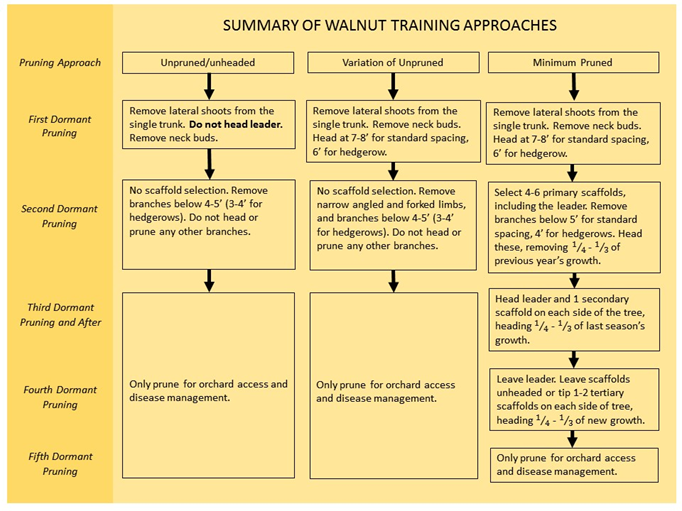
Leave a Reply